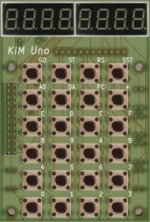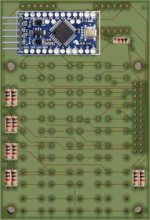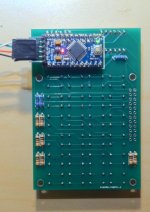Oscar
Experienced Member
Hi,
I just finished a KIM-1 emulator that runs on the Arduino Uno. I could not come up with a more creative name than KIM Uno, for which I apologise...
But although I'm planning to add some more functionality in the coming weeks, the current version seems to work well. It only requires a basic Arduino Uno using its serial port, but also supports an add-on shield with LEDs and keyboard for that all-important retro feeling.
I found the 6502 emulating code in a post of Miker00lz on the Arduino forum, so all I did was to implement the KIM-1 on top of that. I/O through the 6530 RIOTs is not seriously supported yet, other than to support the LEDs and keyboard.
Plans still to be implemented: use the on-board EEPROM for storage, devise a friendly way to up/download from a PC, store some classic KIM software in the Arduino Flash. Maybe also hook up the Arduino's IO pins to the emulated 6530 IO.
The beta version and a description are here:
http://obsolescenceguaranteed.blogspot.ch/2014/06/kim-uno-kim-i-emulator-on-arduino-uno.html
Also, using the same engine, I cooked up a dedicated chess game for the Arduino. It runs the venerable 6502 Microchess code originally written by Peter Jennings for the KIM-1 with some added comfort (load/save games etc) in the emulation engine. I've had a long fascination with Microchess:
http://obsolescenceguaranteed.blogspot.ch/2014/06/6502-microchess-on-arduino.html
It's work in progress, but comments and suggestions are welcome! As Arduino Uno's have come down in price to $13 or so, it's a very cheap way of owning a KIM
Regards,
Oscar.
I just finished a KIM-1 emulator that runs on the Arduino Uno. I could not come up with a more creative name than KIM Uno, for which I apologise...
But although I'm planning to add some more functionality in the coming weeks, the current version seems to work well. It only requires a basic Arduino Uno using its serial port, but also supports an add-on shield with LEDs and keyboard for that all-important retro feeling.
I found the 6502 emulating code in a post of Miker00lz on the Arduino forum, so all I did was to implement the KIM-1 on top of that. I/O through the 6530 RIOTs is not seriously supported yet, other than to support the LEDs and keyboard.
Plans still to be implemented: use the on-board EEPROM for storage, devise a friendly way to up/download from a PC, store some classic KIM software in the Arduino Flash. Maybe also hook up the Arduino's IO pins to the emulated 6530 IO.
The beta version and a description are here:
http://obsolescenceguaranteed.blogspot.ch/2014/06/kim-uno-kim-i-emulator-on-arduino-uno.html
Also, using the same engine, I cooked up a dedicated chess game for the Arduino. It runs the venerable 6502 Microchess code originally written by Peter Jennings for the KIM-1 with some added comfort (load/save games etc) in the emulation engine. I've had a long fascination with Microchess:
http://obsolescenceguaranteed.blogspot.ch/2014/06/6502-microchess-on-arduino.html
It's work in progress, but comments and suggestions are welcome! As Arduino Uno's have come down in price to $13 or so, it's a very cheap way of owning a KIM
Regards,
Oscar.




